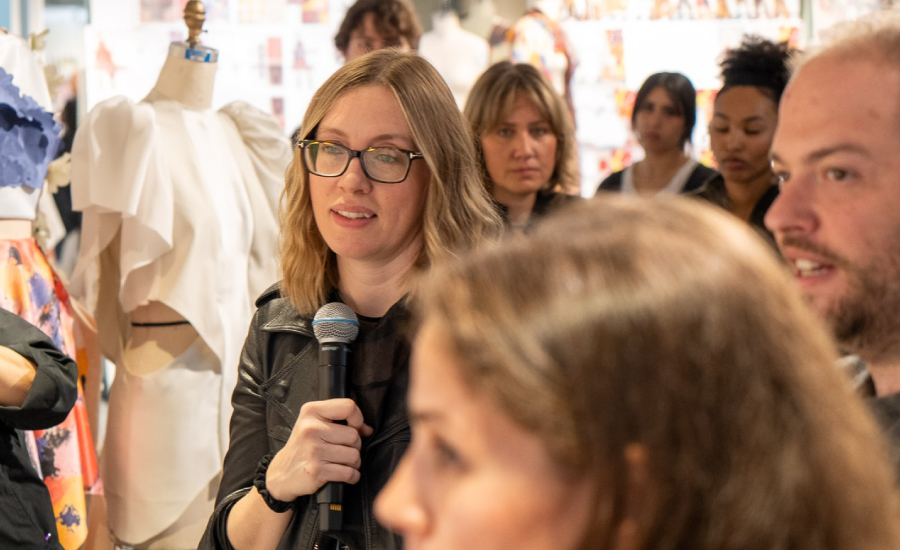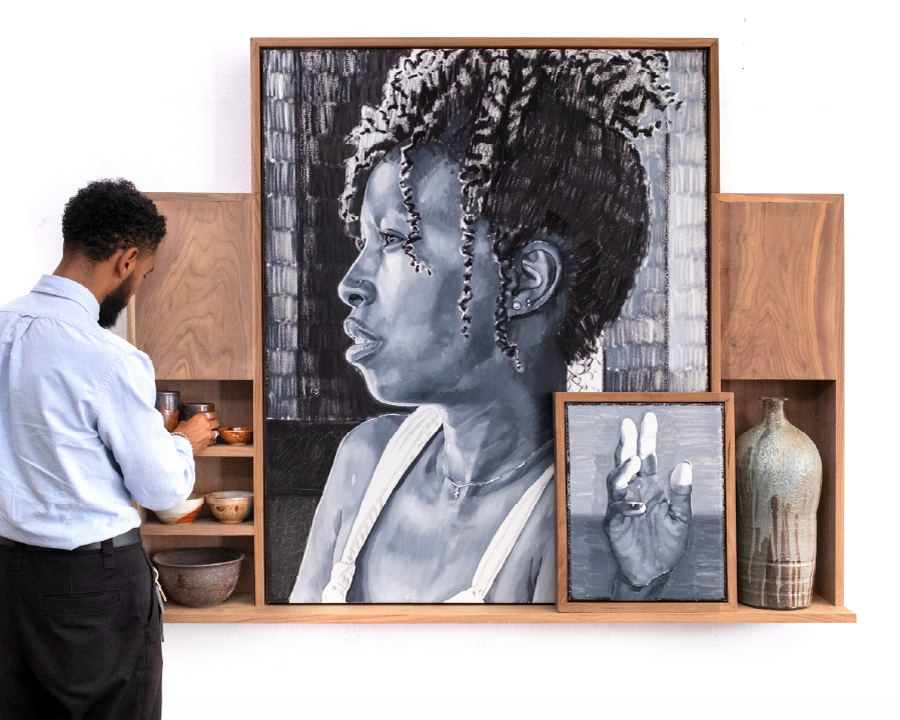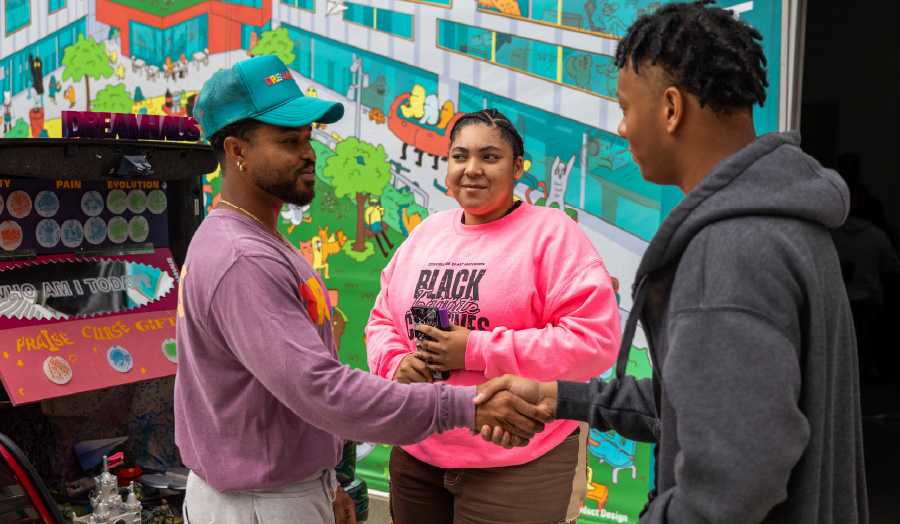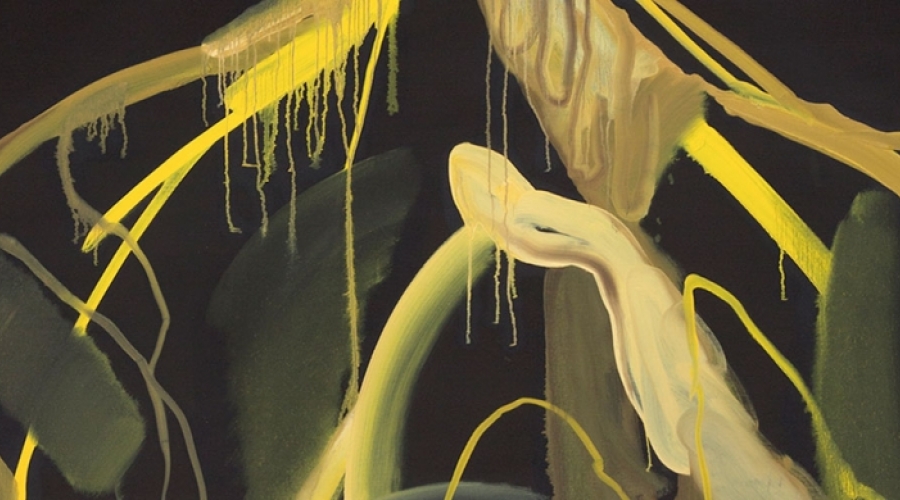
On how the post-grad moment can lead to artistic growth, drawing horses, and the futility of holding onto one idea of L.A.
Born in Los Angeles, Andy Woll received his BFA from Otis College of Art and Design in 2007. He has exhibited work at Bonelli Contemporary, Gallery 3209, and Blum and Poe. His exhibition, Western Wear is on view at the Denny Gallery in New York City from February 15 through March 25, 2018. A new exhibition of work will be on view at the Night Gallery in Los Angeles from April 21, 2018 through May 26, 2018. Woll lives and works in Los Angeles.
When did you realize you wanted to do art?
A: I grew up drawing a lot and I was really into comics and I thought I would like to be a cartoonist. I would tell people that’s what I was going to do. But I wasn’t really thinking about art. I thought I was going to draw Saturday morning comics, single punchline joke comics. And I guess I found art because it started to make the most sense for how I like to work.
I grew up in Venice. I wanted to become a tattoo artist when I was 18. But I hate tattooing. You have somebody else’s idea and then you have to execute it perfectly on their skin. Nothing about that is that interesting to me, although I did take some skills from it, there’s a lot of tracing in tattooing and repetition. And those things have stuck with me. And then I went to Otis and I went with an open mind and I thought I was going to do illustration and I kind of naturally fell into painting.
Then after graduating and my post-college flail, I ended up getting a bunch of different jobs in the art world. I worked for a bronze foundry casting sculptures for artists around town. I got to build a lot of sculptures but I realized that also wasn’t quite the way that I thought. I thought in pictures but I didn’t want to make other people’s pictures. So I slowly found myself where I am with painting and studio practice.
I feel like everybody who studies some creative art probably has that moment when they get out of school and have a moment like—now what. Can you talk a little bit about that, especially for people who might be still in college, any thoughts on what you would say to them? What was the thing that helped you make that transition?
A: It was a really difficult period and I think ultimately I’ve turned that into a good thing for myself but it was a lot of lessons learned and a lot of acceptance about how to work and how to find yourself doing something you enjoy. I started working in galleries and hanging art and none of that was what I had quite gone to school to do, but I knew it was around what I had gone to school to do.
I was thinking about going to grad school. I had thought about it right when I got out and I knew I wanted to take some time and flail for a while. And then I started to realize as I was getting those jobs and working in the art world, one of the big things I was going to get from grad school was to do studio visits. I think at Otis there was a requirement for studio visits every week. And I thought, well if I just do the studio visits, if I ask people to come over, then I won’t have to apply to grad school. I took that really seriously. I pretended I was in grad school and I was working around artists so I would just ask them, hey, come by my studio. And then I had some really harsh studio visits with some really good and smart artists and it progressed from there. That was when I started making work that I felt really good about.
The practice was helpful in a lot of ways, I was getting to talk to people about the work, and it enabled me to get more comfortable talking to a lot of different people about the work; which sounds similar but they are two different things. Some of these visits were with Davida, and William from Night Gallery. These conversations in the studio effectively changed everything. I was thinking a lot about whether I could or should quit my other job and start working in the studio full time, and Davida and Night Gallery were very supportive.
There was one conversation in particular where she basically asked “can you do it?" (Quit the job and not starve) And I said I thought so, and she basically said “then do it” she really urged me to take the opportunity to put that much time and energy into my work, which was a really well-timed push that has led to a lot of positive things for my work.
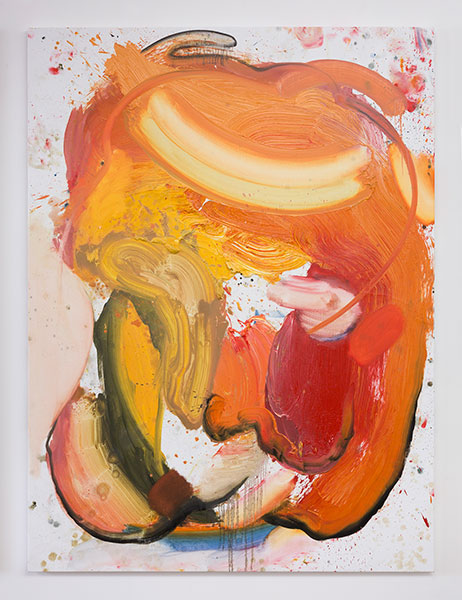
What was it like when you still had the day jobs and you were coming in at night, how did you sustain that and get back into what you were working on versus now when you can come in and you can start a day?
A: Yeah, three hours a night working on art was hard because you can’t really spend a very long time working on anything but I would just go in whether or not I had something to do. Even now it’s a lot of what I do. There’s a lot of it that’s just sitting and looking at stuff. And so I learned that just going in and sitting there in the studio was part of doing the work. If I didn’t have anything to do, I would go and sit and look at stuff. And then if there was something to do I would do it.
What you’ve been interested in in terms of subject and what you’re interested in now?
A: Even since I was a little kid, the series way of working really appealed to me. The series that I’ve been working on the longest is these paintings of Mt. Wilson. It started out where I was just like, how many different paintings can I get out of this? At first it was just that colors would change. And then I started changing the forms and letting it become more abstract, but still recognizable as a mountain. And then that started to really break down and I started adding figures into the work. The mountain is personally significant to me, but it’s a thing that’s just a subject and the painting itself is more the content of the art.
One thing I liked about the mountain was how easy it was to paint so I could keep doing it and get different paintings out of it without questioning so much whether or not it worked. I was like, it looks like a mountain, it works. I like that in a subject. I’m trying to do horses now and horses are not easy to paint. They’re incredibly difficult. And I don’t know, in my mind a horse would be a good thing for me to paint and it should work and I’ve gotten some good paintings out of it but it’s really challenging.
And I like that part of painting and I also hate it. It’s like you come in every day and you look at something that might be ugly and you’re sitting there with that feeling of, this might suck. In a painting studio if you’re with a lot of unfinished work, you’re surrounded by stuff that might be failing and might be evidence that you’re a bad artist. And you have to sit through that. You have to paint through and get to a good piece eventually.
I’ve been doing palette paintings which is something a lot of painters do. And some of the stuff I really like just comes along, as you’re making the work. So the palette paintings, they’re kind of process paintings but I’ve been doing them now on stretched canvas and treating them like paintings in their own right. And the way it feels to look at that painting, it’s different than the way it feels to look at this painting with the horses but they make sense together in a weird way.
How do you use other work as reference and a springboard for your own work?
A: I steal palettes and ideas and forms from other painters. I like to have a really rough reference so I print them out on inkjet prints on paper and throw them on the ground. I have them kicking around as I work so I can look at them if I need to. But I don’t want to know exactly what the paintings look like. So the palettes I steal are sometimes just the most basic set of colors they started with. I use the internet a lot for that. You can find anything on the internet now.
Ultimately the biggest problem is, what do you paint? How do you do it? And for that there’s not really anybody to help you.
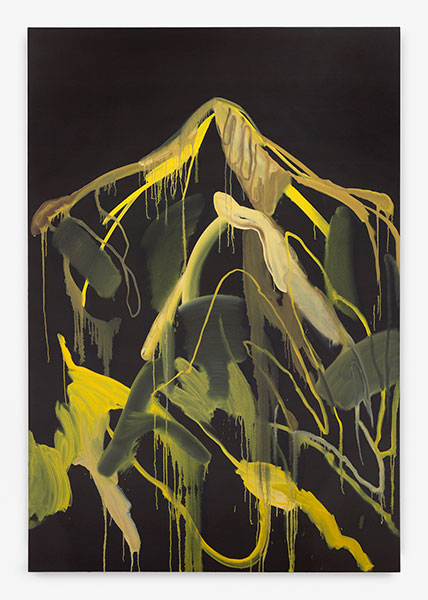
What would you say is your biggest challenge at this point?
A: I guess the challenge is always to keep growing but to know which direction to grow and what to do next. One of the difficult parts of being an artist is actually making the work and that, I feel good about. And then there’s the part where you have to get out there and meet people and talk. That’s always been a challenge. I trick myself into doing it in different ways but I’m pretty introverted and I have a difficult time going out and staying out. But I force myself and I have rules for myself about how much to do. But it’s hard, the social aspect of being an artist. I always have in my mind, oh someday all I’ll have to do is sit in the studio. I’m sure if I actually got that it wouldn’t feel that good, like I’d be stuck here all the time.
Let’s talk about L.A. You grew up here and you went to school here. How do you think about it and how has it changed?
A: I grew up in Venice Beach so it always seemed like the hot place to be. It’s a city of tourism. But I always had the sense that this is a city that’s constantly changing. It used to be exciting to think that a whole new building had gone up since I went on vacation. And downtown doesn’t look anything like downtown used to look. Some of the murals are still there. If you’re living in Venice, there’s almost no way for it to feel like your town. Venice, every weekend, it’s somebody else’s town. Hollywood is similar. It’s a little weird when I hear people trying to maintain some part of Los Angeles as it is. It seems a little futile or something. But I love Los Angeles, it’s my favorite city. I’ve been a lot of different places. I tried to live in Germany. Los Angeles is in my work a lot, everything is Los Angeles locations and definitely color palettes and ideas. I have a lot of love for the city and I can’t think about living anywhere else.
What is it about the city that you love so much?
A: Nobody really owns it, so even when I meet people who are like—this is my town—it is your town but it’s also not your town. I like driving around. Sometimes I go for drives just to get outside of the studio. I love the beach. I was somewhere the other night where somebody was going out to some club or party and I haven’t been to a club in a long time and I told him that. He was like, why do you live in L.A.? That’s awesome, that for this guy L.A. is the clubbing party city. And that’s something that wasn’t really part of L.A. to me, but it’s cool that that’s why this guy lives in L.A. It does also draw people from all over the world so you get to have this crazy group of people in the city.
Check out Woll’s Western Wear at the Denny Gallery in New York City from February 15 through March 25, 2018 and his upcoming exhibition will be on view at the Night Gallery in Los Angeles from April 21, 2018 through May 26, 2018.
